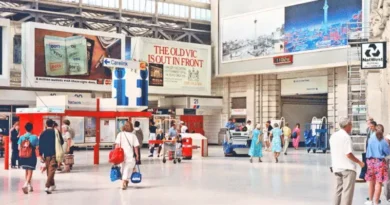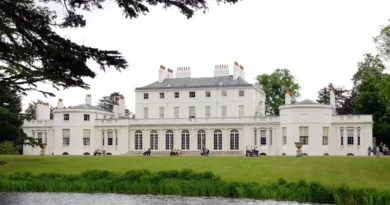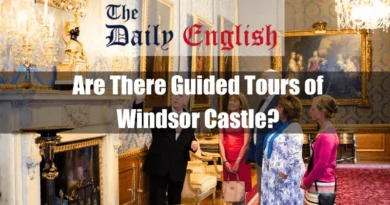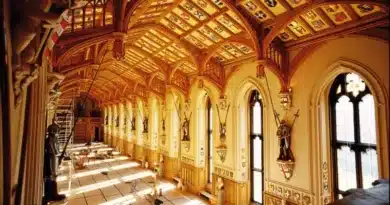Are The Windsor Castle Grounds Open To The Public
Windsor Castle is open to the public five days a week, from Thursday to Monday, and is closed on Tuesdays and Wednesdays. Visitors are welcome to explore various parts of the castle, including the State Apartments, St George’s Chapel, and the surrounding grounds. The castle’s opening hours vary seasonally: from 1st March to 31st October, it operates from 10:00 to 17:15, with the last admission at 16:00; from 1st November to 28th February, it is open from 10:00 to 16:15, with the last admission at 15:00. As Windsor Castle is a working royal palace, certain areas or the entire castle may be closed at short notice for official events. Therefore, checking the latest information before planning your visit is advisable.
Takeaways
| Key Points |
|---|
| Windsor Castle, the world’s oldest and largest occupied castle, has been a royal residence since the 11th century and remains an official residence of His Majesty The King, welcoming visitors five days a week from Thursday to Monday, with seasonal opening hours. |
| Admission prices vary based on booking method, with discounts available for young persons, children, and disabled visitors, while children under five enter free; Royal Borough residents and those on certain benefits may access special offers, including free or discounted entry. |
| Visitors can explore key attractions such as the State Apartments, adorned with treasures from the Royal Collection, St George’s Chapel, a masterpiece of Gothic architecture and a royal burial site, and the picturesque castle grounds offering stunning views. |
| Due to its status as a working royal palace, certain areas may close at short notice, and the site’s steep terrain necessitates comfortable footwear, while photography is restricted inside the main buildings but permitted in outdoor areas. |
| Facilities include the Undercroft Café, castle shops, accessible toilets, free wheelchair loans, and multimedia guides in multiple languages, while transport links provide easy access via train from London, with public car parks recommended for those arriving by car. |
Introduction
Windsor Castle, the world’s oldest and largest occupied castle, stands as a testament to over a millennium of British royal history. Founded by William the Conqueror in the 11th century, it has been the residence of 40 monarchs and continues to serve as the official residence of His Majesty The King. The castle is open to visitors throughout the year, offering a unique glimpse into the nation’s rich heritage.
Opening Days and Hours
Windsor Castle welcomes visitors five days a week, from Thursday to Monday, and remains closed on Tuesdays and Wednesdays. The opening hours vary seasonally:
- 1st March to 31st October: Open from 10:00 to 17:15, with the last admission at 16:00.
- 1st November to 28th February: Open from 10:00 to 16:15, with the last admission at 15:00.
It’s advisable to allocate between 2.5 to 3 hours for a comprehensive visit, allowing ample time to explore the castle’s numerous attractions.
Admission Prices
Ticket prices are structured to encourage advance booking:
- Adult: £30.00 (advance), £33.00 (on the day)
- Young Person (18-24): £19.50 (advance), £21.50 (on the day)
- Child (5-17): £15.00 (advance), £16.50 (on the day)
Children under 5 enjoy free entry. Concessionary rates are available for disabled visitors, and a complimentary access companion ticket can be booked online.
Access to the Castle Grounds

Visitors have the opportunity to explore various parts of the castle, including the State Apartments, St George’s Chapel, and the surrounding grounds. The State Apartments are renowned for their opulent interiors and house treasures from the Royal Collection. St George’s Chapel, a masterpiece of Gothic architecture, is the spiritual home of the Order of the Garter and the final resting place of several monarchs. The castle grounds offer picturesque views and a chance to appreciate the castle’s imposing architecture from different angles.
Special Considerations
As Windsor Castle is a working royal palace, certain areas or the entire castle may be closed at short notice for official events. Check the latest information before planning your visit. Additionally, the castle is situated at the top of a steep hill, and the visitor route covers long distances. Comfortable footwear is advisable. Photography and filming are not permitted inside the State Apartments or St George’s Chapel but in the Castle Precincts’ outdoor areas.
Visitor Facilities
The Undercroft Café, located in one of the oldest surviving spaces in the castle, offers a selection of refreshments, including sandwiches, salads, and sweet treats. The castle shops provide a range of exclusive gifts and royal souvenirs. Accessible toilets and a Changing Places facility are available on-site. Manual wheelchairs and rollators can be borrowed free of charge on a first-come, first-served basis. Motorised wheelchairs and mobility scooters are permitted, provided they are compatible with the castle’s lifts.
Multimedia Guides
To enhance the visitor experience, free multimedia guides are available in multiple languages, including English, French, German, Italian, Japanese, Mandarin Chinese, Russian, and Spanish. A family multimedia tour for children aged 7-11 is also available in English. These guides provide a comprehensive overview of the castle’s history and its significance through the ages.

Local Residents and Special Offers
Admission to Windsor Castle is free for Royal Borough of Windsor and Maidenhead Advantage Card holders. Tickets can be booked in advance or obtained on the day, subject to availability. From 1st January 2025, Advantage Card holders can enjoy 50% off admission, with free entry for one child up to the age of 17 per adult cardholder. Additionally, from 1st January to 4th April 2025, £1 tickets are available for individuals on Universal Credit and other specified benefits.
Getting There
Windsor Castle is accessible via public transport, with train services from London Waterloo and London Paddington. The castle has no visitor car parking, so public car parks in Windsor town centre are recommended for those arriving by car. Details about parking can be found on the official Windsor tourism website.
Castle Areas
Windsor Castle, the world’s oldest and largest occupied castle, offers visitors a wealth of historical and architectural marvels. The areas accessible to the public provide a comprehensive insight into the castle’s rich heritage and its role as a working royal residence.
State Apartments
The State Apartments are a series of grand rooms that reflect the tastes of successive monarchs. Lavishly furnished with some of the finest treasures from the Royal Collection, including paintings by renowned artists, intricate tapestries, and exquisite furniture, these rooms serve as the setting for official state occasions and ceremonies. Visitors can admire the opulent décor and gain insight into the ceremonial aspects of the British monarchy.
Semi-State Rooms
The Semi-State Rooms, created for King George IV, are among the most richly decorated interiors in the castle. Used by the King for private entertaining, these rooms are adorned with elaborate furnishings and artworks. They are open to visitors from autumn to spring each year, offering a glimpse into the more personal quarters of the royal residence.
St George’s Chapel
A masterpiece of Gothic architecture, St George’s Chapel is the spiritual home of the Order of the Garter, the oldest order of chivalry in the world. It is also the final resting place of numerous monarchs, including Henry VIII and Charles I. The chapel remains an active place of worship, with daily services that visitors are welcome to attend. Please note that the chapel is closed to Sunday visitors except those attending services.
Queen Mary’s Dolls’ House
Queen Mary’s Dolls’ House is an extraordinary exhibit, a perfect replica of an aristocratic home, complete with working electricity, running water, and miniature items crafted by leading artists and designers of the 1920s. This intricate creation offers a fascinating glimpse into the period’s craftsmanship and domestic life.
The Moat Room
Located in the castle’s lower ward, the Moat Room features a detailed scale model of Windsor Castle, providing an overview of the site’s development over the centuries. This exhibit is particularly useful for understanding the castle’s extensive history and architectural evolution.
Castle Precincts
The castle’s grounds, known as the Precincts, encompass a variety of historic buildings, courtyards, and gardens. Visitors can explore these areas, taking in views of the imposing Round Tower and the picturesque surroundings. The Precincts also host the Changing the Guard ceremony, a traditional display of British pageantry that occurs on select days.
The Round Tower
Situated at the heart of Windsor Castle, the Round Tower is an iconic structure that dates back to the reign of Henry II in the 12th century. Historically, it has played a crucial role in the castle’s defences and administration. While the interior is not regularly open to the public, the tower’s elevated position provides panoramic views of the surrounding countryside, offering a strategic vantage point that has been significant throughout history.
Waterloo Chamber
Architect Jeffry Wyatville designed the Waterloo Chamber to commemorate the defeat of Emperor Napoleon Bonaparte at the Battle of Waterloo. The chamber is adorned with portraits of prominent figures who played key roles in Napoleon’s defeat. Today, it remains an important room within the castle, hosting the annual Garter Day luncheon and other significant events.
Garter Throne Room
The Garter Throne Room is the venue for ceremonies of the Order of the Garter, the oldest and most prestigious British chivalric order. The room features magnificent Gothic-style windows, intricate wood panelling, and a soaring vaulted ceiling adorned with elaborate carvings. The Garter Throne is the room’s focal point, where the Sovereign sits during Garter ceremonies.
East Terrace Garden
The East Terrace Garden, first laid out by George IV in the 1820s, features a formal rose garden and offers picturesque views over the Home Park. In recent years, the garden has been opened to the public for limited periods, allowing visitors to appreciate its beauty and historical significance.
Each of these areas contributes to a comprehensive understanding of Windsor Castle’s historical significance and its ongoing role in the life of the British monarchy.
Conclusion
Windsor Castle offers a rich and immersive experience of British royal history. With its accessible facilities and comprehensive visitor services, it ensures a memorable visit for all. Whether you’re exploring the magnificent State Apartments, reflecting in the serene St George’s Chapel, or strolling through the historic grounds, Windsor Castle provides a unique window into the nation’s regal past and present.
FAQ
Can visitors access the State Apartments?
Yes, visitors can explore the State Apartments, which are open to the public and showcase the ceremonial rooms used by the Royal Family. These opulent spaces are adorned with magnificent artworks and intricate designs, offering a glimpse into the grandeur of royal life.
Are the Semi-State Rooms open to the public?
Yes, the Semi-State Rooms are accessible to visitors only during specific times of the year. They are open from autumn until spring each year, allowing guests to experience these richly decorated private apartments used by George IV.
Is Queen Mary’s Dolls’ House on display?
Yes, Queen Mary’s Dolls’ House is on permanent display and can be viewed by visitors. This intricate miniature house is renowned for its exquisite craftsmanship and attention to detail, featuring working lights, running water, and a collection of tiny books and artworks.
When can visitors tour St George’s Chapel?
St George’s Chapel is open to visitors on Mondays, Thursdays, Fridays, and Saturdays. While it is closed to visitors on Sundays, it remains open for worship. This historic chapel is the site of numerous royal ceremonies, including weddings and burials.
Is the Round Tower accessible to visitors?
No, the Round Tower is not generally open to the public. However, special tours may be available during certain times of the year, offering panoramic views and insights into its historical significance.
Can the public tour the Private Apartments?
No, the Private Apartments used by the Royal Family are not open to visitors. These personal living quarters remain off-limits to the public to ensure the privacy and security of the residents.
Is the Moat Room open to visitors?
Yes, the Moat Room is open to visitors and offers insights into the Castle’s history. This area provides informative displays and exhibits that delve into the rich past of the castle and its inhabitants.
Can visitors dine at the Undercroft Café?
Yes, visitors can enjoy refreshments in the Undercroft Café during their visit. Located within the castle, this café offers a selection of food and beverages in a historic setting, providing a pleasant break during your tour.
Is the North Terrace part of the visitor route?
Yes, the North Terrace is part of the visitor route and offers stunning views over the surrounding area. This vantage point provides a unique perspective of the castle’s architecture and the landscape beyond.
Is the South Wing open to the public?
No, the South Wing contains private apartments and is not open to visitors. This section of the castle serves as the residence for members of the Royal Family and their guests, maintaining their privacy.
Can visitors see the Waterloo Chamber?
Yes, the Waterloo Chamber is part of the State Apartments and is open to visitors. This grand room was created to commemorate the defeat of Napoleon at the Battle of Waterloo and is adorned with portraits of key figures from that era. Its impressive architecture and historical significance make it a highlight of the tour.
Is the Crimson Drawing Room accessible to visitors?
Yes, the Crimson Drawing Room is within the State Apartments and is open to visitors. This richly decorated room features crimson furnishings and intricate designs, reflecting the opulence of the royal residence. It offers insight into the lavish settings used for royal gatherings.
Can the public view the Grand Reception Room?
Yes, visitors can admire the opulent Grand Reception Room during their tour. This magnificent room is used for official state occasions and is adorned with chandeliers, gilded mouldings, and exquisite artworks, showcasing the grandeur of the monarchy.
Are King George IV’s Private Apartments open to visitors?
No, King George IV’s Private Apartments are not open to the public. These rooms are reserved for private use and are not included in the standard visitor route, maintaining the privacy of the royal quarters.
Is the Long Walk accessible to the public?
Yes, while not inside the Castle, the Long Walk is a scenic avenue leading up to Windsor Castle and is open to the public. This iconic tree-lined path stretches approximately 2.65 miles through Windsor Great Park, offering picturesque views and a popular spot for leisurely walks.
Can visitors access the Quadrangle?
No, the Quadrangle is a private area used for official ceremonies and is not open to visitors. This central courtyard is where ceremonial events, such as the Changing of the Guard, take place, but public access is restricted to preserve its formal function.
Are the Royal Archives open to the public?
No, the Royal Archives are not open to visitors. These archives house historical documents and records pertaining to the monarchy and are accessible only to researchers by special permission, ensuring the preservation and confidentiality of sensitive materials.
Is the Albert Memorial Chapel accessible to visitors?
Yes, the Albert Memorial Chapel is located within the Castle grounds and is open to visitors. This ornate chapel, dedicated to Prince Albert, features elaborate decorations and memorials, offering a glimpse into Victorian-era artistry and royal history.
Can the public tour the Castle Gardens?
No, the private gardens of Windsor Castle are not open to the public. These gardens are reserved for the private enjoyment of the Royal Family and are not included in the standard visitor route, maintaining their exclusivity and privacy.
Is the Changing of the Guard ceremony open to visitors?
Yes, visitors can witness the Changing of the Guard ceremony on the castle grounds. This traditional ceremony, where the new guard takes over duties from the old guard, is a popular attraction and typically takes place on specific days. It’s advisable to check the schedule in advance to plan your visit accordingly.
Is Windsor Castle accessible for visitors with mobility impairments?
Yes, Windsor Castle offers various facilities to assist visitors with mobility impairments, including step-free routes, lifts, and manual wheelchairs available on a first-come, first-served basis.
Are there lifts available within the Castle?
Yes, several lifts in key areas of the Castle provide step-free access, such as a platform lift on the North Terrace and another near the Cloakroom in the Inner Hall.
Is assistance available for blind or partially sighted visitors?
Yes, the Castle provides a descriptive audio tour produced in conjunction with VocalEyes, which is available free of charge. Additionally, assistance animals are welcome throughout the Castle.
What provisions are there for D/deaf or hard-of-hearing visitors?
A hand-held British Sign Language (BSL) video tour is available, which also includes sound and subtitles. Induction loops are installed at ticket sales desks, shop tills, and the audio tour collection point.
Are there accessible toilet facilities?
Yes, accessible toilets are located after the Security Hall near the start of the visit, on the North Terrace before the entrance to the State Apartments, and next to the Undercroft Café. A Changing Places facility is also available in Engine Court.
Is there parking available for visitors with disabilities?
While there is no parking available at Windsor Castle itself, the nearest disabled parking bays are located on the High Street outside the Harte & Garter Hotel and Nando’s, as well as on Park Street. The Castle Admission Centre is a short, uphill walk from these locations.
Can visitors with autism spectrum conditions access tailored support?
Yes, the Castle provides resources and support for visitors on the autism spectrum. A detailed guide is available for download, and staff are on hand to assist during the visit.
Are assistance animals permitted inside the Castle?
Yes, assistance animals are welcome throughout Windsor Castle. It is recommended that they wear a jacket or lead slip to identify them as working animals.
Is the Undercroft Café accessible to visitors with disabilities?
Yes, the Undercroft Café is accessible via platform lifts, ensuring all visitors can enjoy the refreshments.
Are there any provisions for visitors with visual impairments in St George’s Chapel?
Orders of Service are available in large print, and some are available in Braille for use during St George’s Chapel services.
Can visitors with hearing impairments participate in guided tours?
Yes, the multimedia tour is available in British Sign Language and includes subtitles. Handsets are T-coil compatible and equipped with volume control; neck loops are also available on request.
Is there seating available for visitors who may need to rest?
Limited seating is available in the State Apartments upon request, and seating is available in the Nave of St George’s Chapel. Visitors are also welcome to use walking sticks or folding stools with seat attachments, provided they have rubber stoppers.
Are there accessible routes throughout the Castle?
Yes, Windsor Castle has implemented step-free routes and alternative access points to accommodate visitors with mobility needs. For example, while there are steps in certain areas, platform lifts and alternative pathways are available to ensure accessibility.









